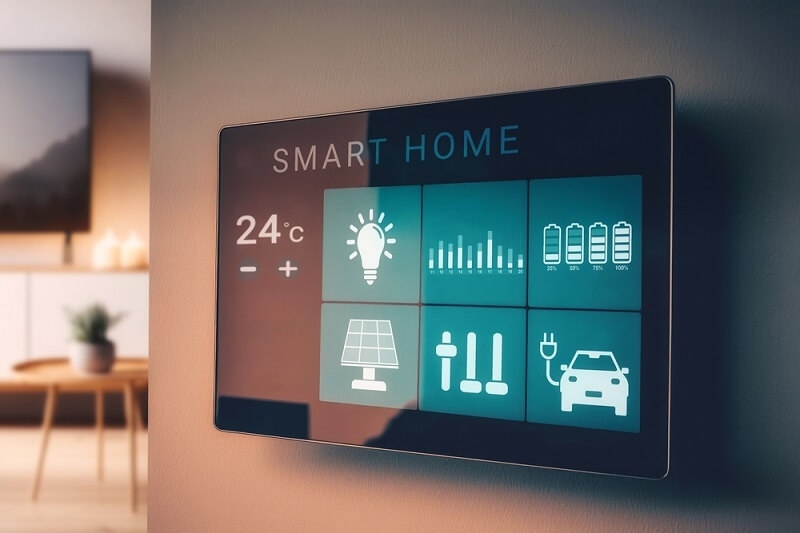
Today’s U.S. household is more connected than ever, with smart speakers, security cameras, smartwatches, tablets, robotic systems, and many cords. These devices can add usefulness and provide convenience and automation, but often lead to visual clutter and organizational dilemmas. If your coffee table is a charging station or your entertainment center resembles a cyclone of cords, this is your complete guide to decluttering smart devices and combating cable clutter in U.S. households.
Using a bit of strategy and some tools, you can re-establish order and tranquility in your living areas while continuing to enjoy your technology in a connected way. This guide will explore decluttering smart devices, reviewing and refining charging stations, establishing an innovative labeling system, and freeing your home's aesthetic.
When there’s clutter everywhere and cables are all over the place, they can overwhelm your eyes and brain and add to your daily stress.
Arranging your device setup and organizing and labeling the cables removes the hassle and effort associated with using, charging, and maintaining your devices.
When you store your devices properly and organize the cables, you are less likely to fray a wire or overheat a cable, prolonging your device's lifespan.
If cords are not appropriately managed, tangled cords can be a tripping hazard on the floor, and overloaded cords can be a fire hazard, as it can be dangerous to have too many cables coiled up.

Before organizing your devices, first take inventory. Organize your devices into categories:
Consider keeping that list, as you will use it to help you group your devices in later steps. If you're not using a device regularly, ask yourself if you can donate it or store it elsewhere so it is out of the way.
A tidy, smart home starts with strategic placement.
Set up a central location with multi-device charging hubs to avoid scattered plugs around the house. Look for stations with cable organizers and dividers for multiple gadgets.
You can keep smart lighting controls in the living room, smart speakers in communal areas, and fitness trackers near your nightstand.
Mount your smart home hubs (like Wi-Fi routers or Echo devices) on walls or furniture to reduce cord clutter. Could you tie the excess length with coiled organizers or cord sleeves?
Cable clutter is the most frustrating part of any smart home. Here's how to organize smart home cables effectively.
Hide power strips inside cable boxes. Route wires through cord sleeves or raceways for a neat, streamlined appearance.
Bundle cables using Velcro straps or twist ties. Avoid coiling tightly to prevent overheating or damage.
Labeling is essential for multiple devices and similar chargers. Use:
This prevents mismatched cables, especially for households with multiple users and similar tech.
Instead of long, tangled cords, buy cables that are just long enough for their purpose. Shorter cables reduce the need for bundling.
We all have them—the chaotic junk drawer packed with tangled chargers and mystery tech. Apply these tech drawer decluttering tips to reclaim your space:
Lay everything out and group by category: cables, adapters, old phones, batteries, and manuals.
Plug in cables to see if they work. Discard frayed or duplicate ones. Recycle responsibly through e-waste services.
Compartmentalized trays or zippered tech pouches help keep items visible and separated.
Turn a kitchen or office drawer into a smart charging station with USB ports, surge protection, and ventilation.
Buying every new gadget is tempting, but more isn’t always better. Use these tips to declutter smart devices at the system level:
Choose one primary platform to reduce app overload if you have multiple brands or ecosystems (Alexa, Google, Apple).
Don’t keep three fitness trackers or two intelligent assistants in one room. Store, donate, or repurpose older tech.
Revisit your device inventory regularly. Unused devices still draw phantom energy if plugged in.
Creating intentional setups adds both style and function to your home.
TV stands, nightstands, and desks often come with cutouts for cable management. Use them!
Smart speakers, cameras, and routers can be mounted to walls or the underside of shelves for a cleaner look.
Tech baskets, neutral-colored cable wraps, and labeled boxes help devices blend with your decor.
Stick power bricks under desks or behind furniture using adhesive clips or trays.
To avoid congestion and confusion in your charging area:
This reduces clutter and extends the lifespan of your batteries through scheduled charging.
For compatible devices, wireless pads eliminate messy cords. Use dual or trio charging pads for phones, watches, and earbuds.
Smart plugs and power strips can automatically turn off unused devices at night, reducing cable heat and saving energy.
Flat or braided cables are more durable and flexible, allowing them to run discreetly along surfaces or under rugs.
In this age of digital connectivity, tech clutter is just the new household clutter. However, with some planning and the proper tools, you can finally turn chaos into order. This guide on how to declutter smart devices and bring order to cable chaos in U.S. homes equips you to keep a tech setup that is clean, safe, and stylish.
Whether splitting cables, labeling chargers, wall-mounting smart hubs, or managing your smart hub cable, these straightforward hacks transform chaos into a serene zone.
Smart living should feel smart, and now it can also look smart.
This content was created by AI